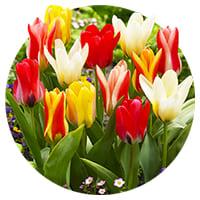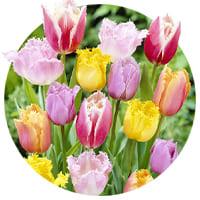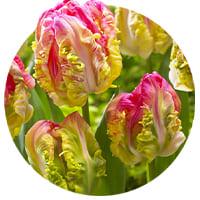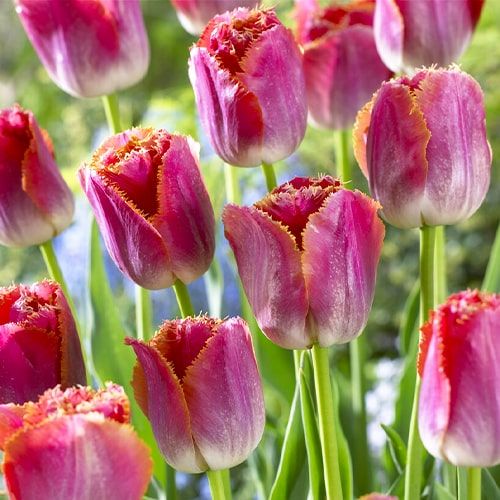
The best selection of Tulip bulbs from Holland. Choose from more than 200 varieties, colours and sizes.
Tulip Bulbs
Tulip Bulbs
Last Reviews
All arrived in perfect condition with new growth starting.
Thank you
Thank you. The prompt delivery with the condition the arrived in was excellent.
Tulip Bulbs: Everything You Need to Know Before Planting
Tulip bulbs are one of the most popular spring-flowering bulbs, known for their bright colors and easy-to-grow nature. Heres everything you need to know before planting tulip bulbs:
- When to Plant: Tulip bulbs should be planted in the fall, ideally six to eight weeks before the first hard frost. This allows the bulbs to establish roots before the ground freezes.
- Where to Plant: Tulips prefer well-draining soil and full sun. They can be planted in beds, borders, and containers.
- How to Plant: Dig a hole about 6-8 inches deep and place the bulb with the pointed end facing up. Space the bulbs about 4-6 inches apart.
- Care: Water the bulbs well after planting and keep the soil moist but not waterlogged. Once the leaves start to grow, fertilize with a balanced fertilizer. After the flowers have faded, allow the foliage to die back naturally before removing it.
Tulip Bulb Types
There are many different types of tulip bulbs, each with its own unique characteristics. Here you can find some of the most common types of tulip bulbs.
Single Early Tulips
Single Early Tulips are a classic springtime symbol, recognized for their delicate delicacy and bright colors. These tulips are among the first to bloom, making them a popular choice among gardeners and flower enthusiasts.
The resilience of Single Early Tulips, which allows them to resist colder temperatures and harsh weather conditions, is one of its key advantages. As a result, they are a popular choice for gardeners wishing to brighten up their outdoor spaces early in the growing season.
Another advantage of Single Early Tulips is their color variety, which includes red, yellow, pink, white, and purple. Because of their brilliant hues, they are famous for providing visual appeal and attractiveness to gardens, parks, and other outdoor places.
Single Early Tulips are also extremely easy to grow, making them an excellent choice for new gardeners or those with minimal gardening knowledge. These tulips may flourish and produce gorgeous blooms year after year with proper care and attention.
Double Early Tulips
Double Early Tulips are a highly sought-after tulip variety valued for its beautiful beauty and distinct qualities. These tulips are notable for their huge, completely double blooms with layers of ruffled petals in pink, red, yellow, orange, and white that mimic peonies.
One of the primary benefits of Double Early Tulips is their early blooming time, which occurs in April, just as the spring season begins. As a result, they are a popular choice for gardeners looking to add a splash of color to their landscape early in the season.
Another reason for the great value of Double Early Tulips is their outstanding toughness and durability. These tulips can resist difficult weather conditions such as strong winds and heavy rain while retaining their vivid colors and exquisite charm.
Triumph Tulips
Triumph tulips are a prominent and highly sought-after tulip variety. These flowers, with their robust stems and traditional tulip form, make a bold impression in any garden or landscape. They are prized for their long-lasting blooms and ability to bring a touch of elegance and sophistication to any situation.
The rich, bold colors of Triumph tulips are one of its most distinguishing characteristics. They are available in a variety of colors, including deep reds, vivid yellows, and gentle pinks. The flowers have a single cup-shaped bloom per stalk and are perfect for formal arrangements or as independent focal points in a garden.
Triumph tulips are also known for their capacity to survive extreme weather conditions. They have a sturdy stem that is resistant to wind and rain, making them a dependable and long-lasting option for gardeners. They are extremely popular for cut flower bouquets due to their lengthy vase life.
Darwin Hybrid Tulips
Darwin Hybrid tulips are a popular and sought-after tulip variety, valued for their large, robust stems, vibrant colors, and long-lasting blooms. These tulips were developed by Dutch horticulturists in the mid-20th century as the result of a hybrid between two wild varieties of tulip and are renowned for their durability and adaptability to a wide range of growing situations.
One of the most distinguishing characteristics of Darwin Hybrid tulips is their robust stems, which make them suitable for cut flowers or planting in windy places. Their big, cup-shaped flowers are available in a variety of brilliant, dramatic hues, including red, yellow, pink, purple, and orange, and have a classic tulip shape with six pointed petals.
Darwin Hybrid tulips are noted for their resilience and simplicity of cultivation, in addition to their visual appeal. They can grow in a number of soil types and are resistant to diseases and pests, making them a low-maintenance option for gardeners of all skill levels.
Single Late Tulips
Single Late Tulips are a popular tulip variety praised for its huge, brilliant blooms and beautiful stems. They are popular among gardeners and flower aficionados for good cause. These tulips are among the latest to bloom in the spring, making them an excellent choice for extending the flowering season.
The size of Single Late Tulips is one of their distinguishing features. These tulips have some of the largest blooms of any tulip species, with flowers up to six inches across. The blossoms are also quite vivid, ranging from deep purples and reds to light pinks and yellows.
Single Late Tulips are adaptable and can be planted in a range of environments. They prefer full sun and well-drained soil, making them an excellent choice for gardens, borders, and pots. They are also low-maintenance and simple to care for, requiring only light watering and fertilizing on occasion.
Fringed Tulips
Fringed tulips, also known as crispa tulips, are a unique and highly sought-after variety of tulip. With their distinctive fringed edges, these tulips are a stunning addition to any garden or floral arrangement.
One of the most notable characteristics of fringed tulips is their frilly, fringed petals, which give the flowers a delicate and ethereal appearance. This unique feature sets fringed tulips apart from other tulip varieties and makes them highly desirable for flower enthusiasts and gardeners alike.
Another benefit of fringed tulips is their wide range of colors, which includes shades of pink, red, white, yellow, and purple. This diversity allows for endless possibilities in floral arrangements and garden designs, making fringed tulips a versatile and valuable addition to any collection.
Fringed tulips are also highly prized for their long blooming period, which can last up to three weeks under the right conditions. This extended period of beauty makes fringed tulips an excellent choice for adding color and vibrancy to any outdoor space.
Parrot Tulips
Parrot tulips are a stunning variety of tulips that are covered by gardeners and flower enthusiasts alike. With their extravagant and flamboyant petals, parrot tulips are a statement flower that commands attention and admiration.
One of the most distinctive features of parrot tulips is their frilled and feathered petals, which often resemble the plumage of a parrot - hence their name. These petals come in a variety of colors, including pink, red, yellow, orange, and purple, and are often marked with intricate patterns and contrasting edges. This unique appearance makes parrot tulips a favorite choice for floral arrangements and gardens that demand drama and flair.
Beyond their striking appearance, parrot tulips are also easy to care for and grow. They prefer well-draining soil and plenty of sunlight, making them an ideal choice for gardens and pots. With proper care, parrot tulips will bloom from mid to late spring and can be enjoyed for weeks on end.
Kaufmanniana Tulips
Kaufmanniana tulips are a gorgeous early-blooming tulip variety that is widely sought after by gardeners and tulip enthusiasts alike. Kaufmanniana tulips, with their brilliant colors and unusual cup-shaped blossoms, are an excellent addition to any garden or landscape design.
The hue of Kaufmanniana tulips is one of their most distinguishing characteristics. These tulips come in a variety of brilliant colors, including red, pink, yellow, and white, with many types including two-tone petals or dramatic streaks of clashing colors.
Greigii Tulips
Greigii tulips are a variety of tulips that are highly recognized for their distinct traits and breathtaking beauty. Tulip hybrids are named for John Greig, a Scottish gardener who discovered them in the early 1900s. They are sure to make a statement in any garden or floral arrangement with their bright and vibrant colors.
Greigii tulips are distinguished by their wide, flat leaves that are often mottled or striped with maroon or brown patterns. These leaves create an appealing backdrop for the tulips eye-catching flowers, which are often cup-shaped and come in a variety of hues, including red, orange, yellow, pink, and purple.
Greigii tulips are also distinguished by their early blooming time. Unlike many other tulips, which bloom in the middle to late spring, Greigii tulips bloom in the early to mid-spring, making them an excellent addition to any garden looking for early-season color.
Fosteriana Tulips
Fosteriana tulips, commonly known as Emperor tulips, are a traditional tulip type that has been grown for centuries for their huge, showy blossoms and brilliant colors. These tulips are native to Central Asias hilly regions and were introduced to Europe in the 16th century, when they immediately became popular because to their outstanding beauty and durability.
Fosteriana tulips are distinguished by their huge, egg-shaped bulbs, which can grow up to 12 cm in diameter. These bulbs grow tall, robust stems up to 60 centimeters tall, which are capped with huge, cup-shaped flowers up to 10 centimeters in diameter.
Fosteriana tulips come in a variety of colors, ranging from vivid reds and yellows to softer pinks and oranges. They are also recognized for their distinct color patterns, which frequently include vivid stripes or mottled patterns on the petals.
Viridiflora Tulips
Viridiflora tulips are a rare and appealing tulip species distinguished by their unusual green-striped petals. Gardening enthusiasts prize these flowers for their eye-catching look and ability to give a touch of elegance to any garden or landscape.
The distinctive green markings on the petals of Viridiflora tulips distinguish them from other types of tulips. These marks are the consequence of a natural mutation that changes the coloration of the tulips petals, resulting in a lovely green stripe that runs down the center of each petal.
Viridiflora tulips are prized for their long-lasting flowers as well as their beautiful look. These flowers bloom for a longer period of time than many other tulip kinds, with blooms lasting up to three weeks or more.
Another benefit of Viridiflora tulips is their adaptability. These flowers can be used in a variety of settings, including formal garden beds and more informal wildflower gardens. They are very popular for floral arrangements because they work well as cut flowers.
Greigii Tulips
Greigii Tulips are a distinctive and eye-catching kind of tulip that is highly regarded by gardeners and flower aficionados worldwide. These tulips are well-known for their striking mottled leaves and large, vivid blooms in a variety of hues and patterns.
The toughness and endurance of Greigii Tulips is one of its most noticeable characteristics. Greigii Tulips have a long flowering season and can continue for several weeks or even months with adequate care, unlike some other tulip kinds, which may only bloom for a few weeks before dying away. As a result, they are an excellent choice for gardeners wishing to add a splash of color and charm to their outdoor settings.
Lily-Flowered Tulips
Lily-flowered tulips are a distinctive and highly sought-after tulip type with exquisite, elongated flowers and pointed, reflexed petals resembling the shape of a lily.
The beautiful, slender stems of lily-flowered tulips, which may grow up to 24 inches in height, are one of their distinguishing characteristics, making them perfect for cut flower arrangements. The petals of the blooms are often pink, purple, white, and yellow, with subtle patterns and streaks that add to their overall beauty.
Lily-flowered tulips are not only visually appealing, but they are also noted for their longevity and tenacity. These tulips can resist strong winds and rain without losing shape or color, making them an excellent choice for any garden or floral show.
Choosing the Right Tulip Bulbs
Tulip bulbs are an excellent choice for adding beauty and charm to your landscape or house. However, with so many tulip bulb kinds available for purchase, it can be difficult to select the best ones. Here are some helpful hints to help you select the best tulip bulbs for your needs.
Consider the color and size of the tulips you want first. Tulip bulbs are available in a variety of colors, including red, yellow, pink, purple, white, and others. They range in size as well, from little and dainty to enormous and flamboyant. Consider the overall style you want to achieve and select tulip bulbs that correspond to your concept.
Another consideration is the time of year when the tulips bloom. Some tulip bulbs bloom earlier in the season than others. Plan ahead of time and select tulip bulbs that will blossom when you want them to.
Planting Tulip Bulbs
Once youve chosen the perfect tulip bulbs, its time to plant them. Heres what you need to know to ensure your tulips grow healthy and strong.
1. Choosing the Right Location for Tulip Bulbs. Tulip bulbs need plenty of sunlight to thrive, so choose a location that gets at least six hours of direct sunlight per day. Avoid areas that are prone to flooding or have poor drainage.
2. Soil Preparation. Before planting tulip bulbs, prepare the soil by removing any weeds and adding compost or other organic matter. Tulip bulbs prefer well-draining soil, so avoid areas that are prone to waterlogging.
3. Planting Time for Tulip Bulbs. The best time to plant tulip bulbs is in the fall, between September and December, depending on your climate. Planting in the fall allows the bulbs to establish a strong root system before the winter months.
4. Planting Depth. Plant tulip bulbs at a depth of around 6 inches, or around three times the height of the bulb. This will help ensure the bulbs dont dry out or freeze during the winter months.
5. Spacing. Space tulip bulbs around 4-6 inches apart to allow room for growth. If planting in rows, space the rows around 12 inches apart.
6. Watering for Tulip Bulbs. Tulip bulbs need regular watering during the growing season, but avoid overwatering as this can lead to bulb rot. Water deeply once a week, or more often if the weather is hot and dry.
Caring for Tulip Bulbs
Tulip bulbs are a popular choice for gardeners who want to add a splash of color to their gardens. However, caring for tulip bulbs requires a certain level of knowledge and effort. In this article, we will discuss some useful tips on how to care for tulip bulbs, reveal the benefits of this beautiful plant, and describe its appearance to help you imagine it in your home interior or garden.
Watering and Fertilizing
Tulip bulbs require regular watering, especially during the growing season. Water deeply once a week, or more often during hot, dry weather. Fertilize the bulbs in the fall when planting, and again in the spring as the leaves emerge.
Deadheading
Deadheading is the process of removing the spent flowers from the plant. This encourages the plant to redirect its energy to the bulbs, rather than to seed production. Deadheading also helps to maintain the appearance of the plant.
Mulching
Mulching is an important step in caring for tulip bulbs. A layer of mulch helps to retain moisture, regulate soil temperature, and prevent weed growth. Apply a layer of mulch in the fall, after planting, and again in the spring as the leaves emerge.
Disease and Pest Control
Tulip bulbs are vulnerable to a variety of diseases and pests. To prevent these problems, make sure to plant tulip bulbs in well-drained soil and avoid overwatering. If you notice signs of disease or pest infestation, treat the problem immediately with an appropriate fungicide or pesticide.
Storing Tulip Bulbs
If you have tulip bulbs left over after planting, store them in a cool, dry place until the next planting season. Bulbs can be stored in a paper bag or mesh bag, and should be checked periodically for signs of rot or disease.
Conclusion
In conclusion, tulip bulbs are a beautiful and rewarding addition to any garden. By following these tips on how to care for tulip bulbs, you can enjoy their vibrant colors and delicate blooms year after year. Whether you are looking to buy tulip bulbs for sale or wholesale tulip bulbs in bulk, there are many options available. Dont be afraid to try planting tulip bulbs in your own garden, and enjoy the beauty they can bring to your outdoor space.
Frequently asked questions about Spring Flowering Tulip Bulbs
When to plant tulip bulbs?
Tulip bulbs need to planted in the fall, 2 to 3 weeks before frost is expected. The bulbs need time to establish themselves. Planting too early leads to disease problems.
What types of tulip bulbs does your online shop offer?
How to plant tulip bulbs?
When is the best time to plant tulip bulbs?
The ideal time to plant tulip bulbs is in autumn, usually from September to November. This allows the bulbs to establish roots before winter arrives and produce beautiful flowers in spring.
Where is the Best Place to Buy Tulip Bulbs?
Do tulips need a lot of care?
Tulips are relatively easy to care for. They need regular watering, especially during the growing season in spring. In addition, a layer of mulch can protect them from frost in winter.
How to Care for Tulip Bulbs?
Why should I buy tulip bulbs from Holland?
Tulip bulbs from Holland are often of high quality, as the Netherlands is known for its expertise in flower bulb cultivation. Buying bulbs from Holland can ensure that you get healthy and robust plants that can thrive.
Can I use tulip bulbs for several years?
Yes, tulip bulbs can usually flower for several years if they are well cared for. However, it may be necessary to stretch and divide them every few years to get the best flowering.































































